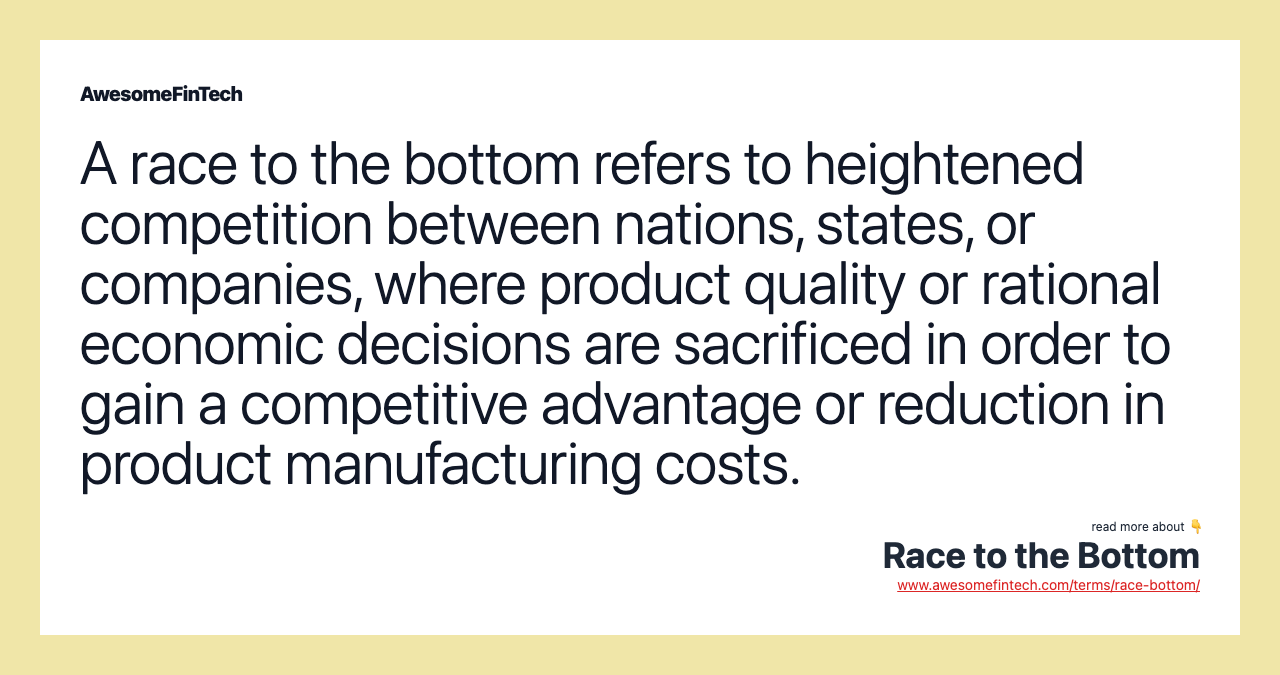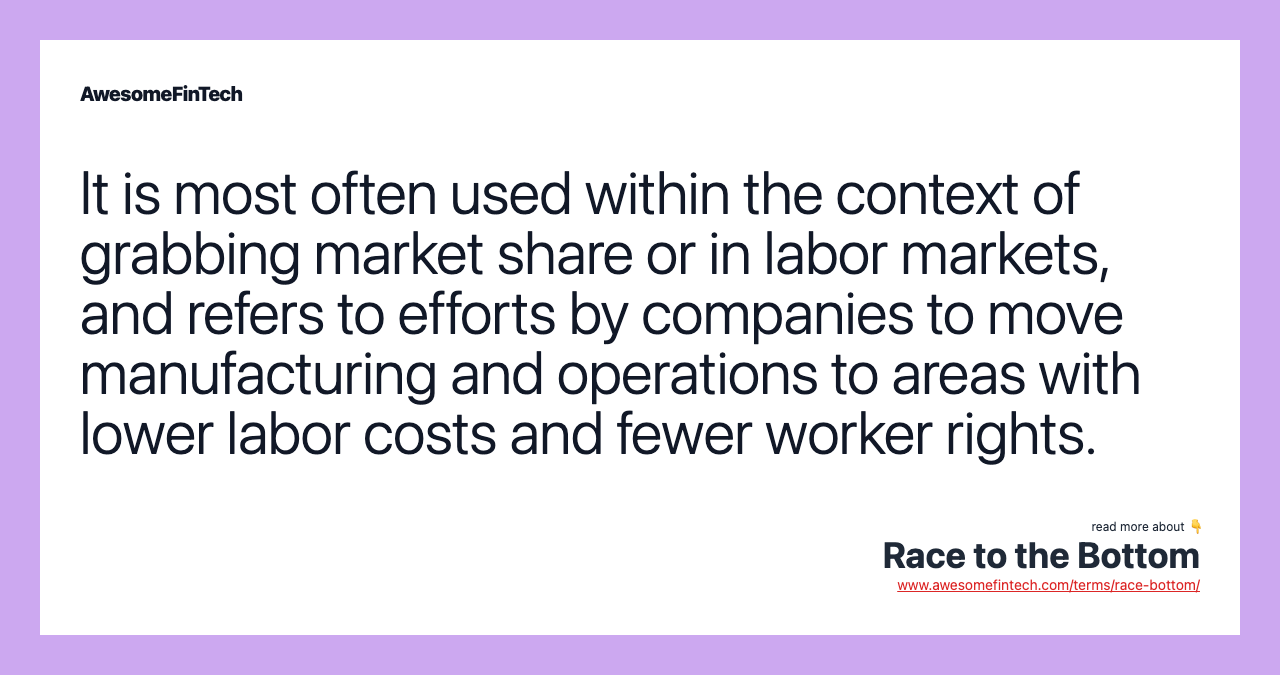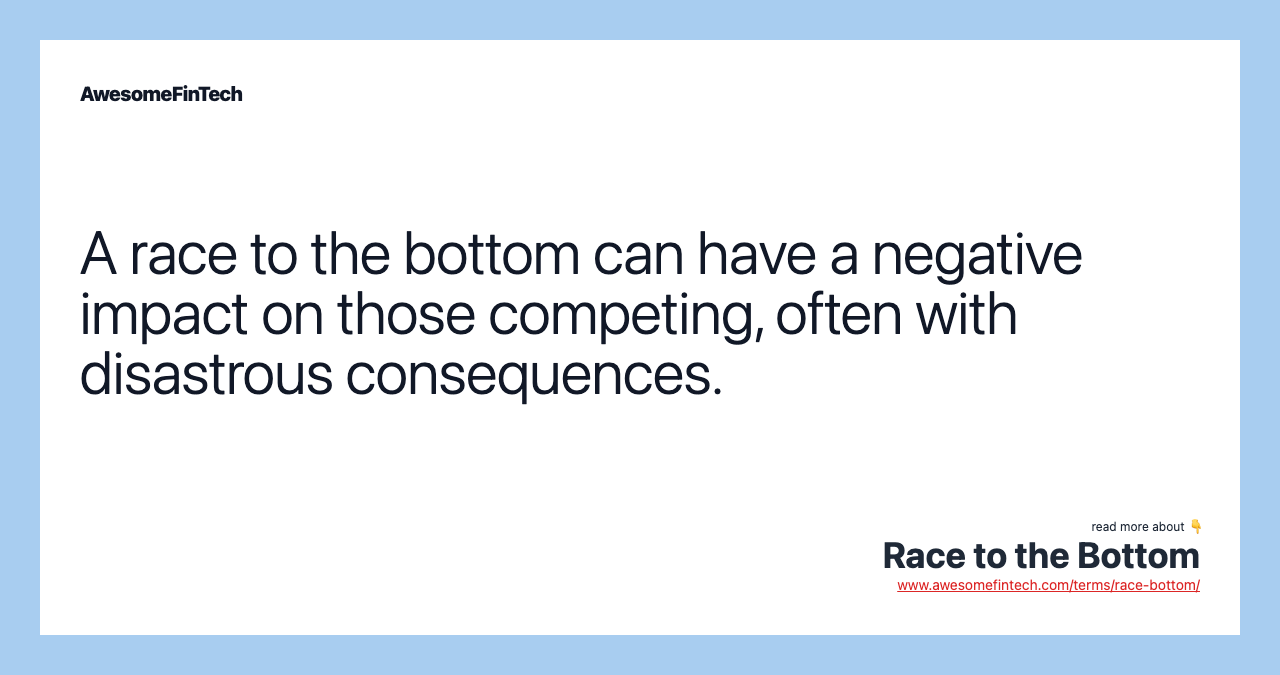Race to the Bottom
The race to the bottom refers to a competitive situation where a company, state, or nation attempts to undercut the competition's prices by sacrificing quality standards or worker safety (often defying regulation), or reducing labor costs. A race to the bottom refers to heightened competition between nations, states, or companies, where product quality or rational economic decisions are sacrificed in order to gain a competitive advantage or reduction in product manufacturing costs. The race to the bottom refers to a competitive situation where a company, state, or nation attempts to undercut the competition's prices by sacrificing quality standards or worker safety (often defying regulation), or reducing labor costs. It is most often used within the context of grabbing market share or in labor markets, and refers to efforts by companies to move manufacturing and operations to areas with lower labor costs and fewer worker rights. The jobs that remain in the domestic market - the in-store functions - may cost more as laws change, but the bulk of labor involved in manufacturing and production can be moved to regions with lower cost labor.

More in Economy
What is the Race to the Bottom?
The race to the bottom refers to a competitive situation where a company, state, or nation attempts to undercut the competition's prices by sacrificing quality standards or worker safety (often defying regulation), or reducing labor costs. A race to the bottom can also occur among regions. For example, a jurisdiction may relax regulations or cut taxes and compromise the public good in an attempt to attract investment, such as the building of a new factory or corporate office.
Although there are legitimate ways to compete for business and investment dollars, the term race to the bottom is used to characterize unhinged tit-for-tat competition that has crossed ethical lines and could be destructive for the parties involved.



Understanding the Race to the Bottom
Justice Louis Brandeis is generally credited with coining the term "race to the bottom". In a 1933 judgment for the case Liggett v. Lee, he stated that the competition between states to entice companies to incorporate in their jurisdiction was "one not of diligence but of laxity", meaning states were relaxing rules and regulations instead of refining them to gain an edge over competitors.
The race to the bottom is thus a result of cutthroat competition. When companies engage in the race to the bottom, its impact is felt beyond the immediate participants. Lasting damage can be done to the environment, employees, the community, and the companies’ respective shareholders. Moreover, consumer expectations of ever lower prices may mean that the eventual victor finds profit margins permanently squeezed. If consumers confront poor quality goods or services as a result of cost cutting during the race to the bottom, the market for those goods or services could dry up.
The Race to the Bottom and Labor
The phrase race to the bottom is often applied in the context of labor and staffing. Many companies go to great lengths to keep wages low to protect profit margins while still offering a competitive product. The retail sector, for example, is often accused of engaging in a race to the bottom and using wage reduction and benefits cuts as easy targets. The sector as a whole resists labor law changes that would increase benefits or wages, which, in turn, would increase costs.
In response to rising wages and demands for benefits, many retail companies have moved the production of goods overseas to regions with lower wages and benefits or have encouraged their suppliers to do so using their purchasing power. The jobs that remain in the domestic market - the in-store functions - may cost more as laws change, but the bulk of labor involved in manufacturing and production can be moved to regions with lower cost labor.
The Race to the Bottom in Taxation and Regulation
In order to attract more business investment dollars, states and national jurisdictions often engage in a race to the bottom by changing their taxation and regulation regimes. The disparity in corporate tax worldwide has seen companies shift their head offices or move operations to obtain a favorable effective tax rate. There is a cost to lost tax dollars because corporate taxes contribute to a country’s infrastructure and social systems. Taxes also support environmental regulations. When a company spoils the environment during production, the public pays in the long run no matter how much of a short-term boost the business activity generated.
In an economically rational world where all externalities are known and considered, a true race to the bottom is not much of a concern. In the real world, however, where politics and money intersect, races to the bottom occur and they are often followed by the creation of a new law or regulation to prevent a repeat occurrence. Of course, over-regulation also has risks and disadvantages to an economy because it deters potential investors from entering a market due to the steep costs and red tape involved in the effort.
Example of a Race to the Bottom
While globalization has created a fertile market for exchange of ideas and trade between countries, it has also resulted in fierce competition between them to attract trade and investment. Large multinational corporations are an especially favored target and the competition is intense among low-income countries hungry for foreign direct investment (FDI).
According to recent research, low-income countries often implement lax labor standards, whether they pertain to wages or safety conditions, to attract manufacturers to their jurisdictions. The Rana Plaza disaster in Bangladesh in 2013 was an example of the perils of this approach. On the back of low wages and cheap costs to set up shop, Bangladesh had become the world's second-biggest garment manufacturing center. The Rana Plaza building in Dhaka was a garment factory that violated several building codes of local laws. But enforcement of those codes was lax, resulting in a collapse that killed 1,000 workers.
Related terms:
Corporate Tax
A corporate tax is tax on the profits of a corporation that generate revenue for a government. read more
Economics : Overview, Types, & Indicators
Economics is a branch of social science focused on the production, distribution, and consumption of goods and services. read more
Effective Tax Rate
The effective tax rate is the percent of income or pre-tax profits that an individual or a corporation pays in taxes. read more
Externality & Examples
An externality is an economic term referring to a cost or benefit incurred or received by a third party who has no control over how that cost or benefit was created. read more
Foreign Direct Investment (FDI)
A foreign direct investment (FDI) is a purchase of an interest in a company by a company located outside its own borders. read more
Inflation
Inflation is a decrease in the purchasing power of money, reflected in a general increase in the prices of goods and services in an economy. read more
Maquiladora
A maquiladora is a Spanish term for a factory located near the United States-Mexico border that operates under a favorable duty- or tariff-free basis. read more
Productivity
Productivity measures the efficiency of production in macroeconomics. Read about productivity in the workplace and how productivity impacts investments. read more
Profit Margin
Profit margin gauges the degree to which a company or a business activity makes money. It represents what percentage of sales has turned into profits. read more
Purchasing Power
Purchasing power is the value of a currency in terms of the goods or services one unit of it can buy. Discover how purchasing power impacts investors. read more